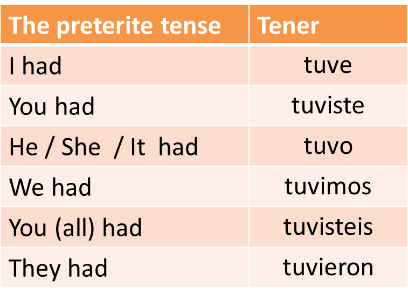Tener In Past Tense

Understanding “Tener” in the Past Tense: A Comprehensive Guide
The Spanish verb “tener” is one of the most essential and versatile verbs in the language. While it primarily means “to have,” its usage extends far beyond simple possession. In the past tense, “tener” is used to express a wide range of meanings, including age, emotions, physical states, and obligations. This article delves into the past tense conjugation of “tener,” its various applications, and provides practical examples to enhance your understanding.
Conjugation of “Tener” in the Preterite (Simple Past)
The preterite tense is used to describe completed actions in the past. Here’s how “tener” is conjugated in this tense:
| Subject Pronoun | Conjugation |
|---|---|
| Yo | tuve |
| Tú | tuviste |
| Él/Ella/Usted | tuvo |
| Nosotros | tuvimos |
| Vosotros | tuvisteis |
| Ellos/Ellas/Ustedes | tuvieron |

Example Sentences: - Yo tuve un perro cuando era niño. (I had a dog when I was a child.) - Tú tuviste mucha suerte ayer. (You had a lot of luck yesterday.) - Él tuvo una idea brillante. (He had a brilliant idea.)
Conjugation of “Tener” in the Imperfect Tense
The imperfect tense describes ongoing or repeated actions in the past, as well as states of being or conditions. Here’s the conjugation of “tener” in the imperfect:
| Subject Pronoun | Conjugation |
|---|---|
| Yo | tenía |
| Tú | tenías |
| Él/Ella/Usted | tenía |
| Nosotros | teníamos |
| Vosotros | teníais |
| Ellos/Ellas/Ustedes | tenían |
Example Sentences:
- Yo tenía 10 años en esa foto. (I was 10 years old in that photo.)
| Note: When expressing age, “tener” is always used in the imperfect tense.
- Nosotros teníamos mucho trabajo durante la semana. (We had a lot of work during the week.)
- Ellos tenían una casa en el campo. (They had a house in the countryside.)
Key Uses of “Tener” in the Past Tense
Expressing Age
- Tuve 20 años el año pasado. (I was 20 years old last year.)
- Ellos tenían 30 años cuando se casaron. (They were 30 years old when they got married.)
- Tuve 20 años el año pasado. (I was 20 years old last year.)
Describing Physical States or Conditions
- Yo tuve hambre después del entrenamiento. (I was hungry after the workout.)
- Nosotros teníamos frío en la montaña. (We were cold in the mountains.)
- Yo tuve hambre después del entrenamiento. (I was hungry after the workout.)
Indicating Emotions or Feelings
- Tú tuviste miedo durante la tormenta. (You were scared during the storm.)
- Ella tenía mucha paciencia con los niños. (She had a lot of patience with the children.)
- Tú tuviste miedo durante la tormenta. (You were scared during the storm.)
Expressing Obligations or Necessities
- Tuvimos que estudiar toda la noche. (We had to study all night.)
- Ellos tuvieron que cancelar el viaje. (They had to cancel the trip.)
- Tuvimos que estudiar toda la noche. (We had to study all night.)
Describing Possession
- Yo tuve un coche rojo. (I had a red car.)
- Vosotros teníais muchas responsabilidades. (You all had many responsibilities.)
- Yo tuve un coche rojo. (I had a red car.)
Common Mistakes to Avoid
Practical Exercises
Historical and Cultural Context
The verb “tener” has deep roots in Latin, evolving from the Latin verb “tenēre,” meaning “to hold.” Its versatility in Spanish reflects the language’s adaptability to express complex ideas succinctly. For example, the phrase “tener ganas de” (to feel like doing something) showcases how “tener” extends beyond literal possession to convey desire or inclination.
Future Trends and Modern Usage
In contemporary Spanish, “tener” continues to evolve in colloquial expressions. Phrases like “tener que ver con” (to have to do with) and “tener en cuenta” (to take into account) are increasingly common in both written and spoken language. Understanding its past tense forms is crucial for mastering these modern expressions.
When do I use the preterite vs. imperfect with "tener"?
+Use the preterite for completed actions (e.g., "Yo tuve un accidente"). Use the imperfect for ongoing states or conditions (e.g., "Yo tenía un gato").
Can "tener" be used to express emotions in the past?
+Yes, "tener" is often used to express emotions in the past, such as "Tuve miedo" (I was scared) or "Ella tenía alegría" (She was happy).
How do I express age with "tener" in the past?
+Always use the imperfect tense for age, e.g., "Yo tenía 15 años" (I was 15 years old).
Conclusion
Mastering the past tense forms of “tener” is essential for fluency in Spanish. Whether you’re describing past possessions, expressing emotions, or stating obligations, understanding when to use the preterite or imperfect tense will significantly enhance your ability to communicate effectively. Practice regularly, and don’t hesitate to immerse yourself in Spanish media to reinforce your learning.